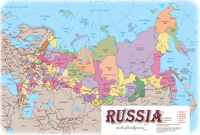
Russia
|
◄ Europe |
Geography
Country name: Russian Federation (local: Rossiyskaya Federatsiya). Former: Russian Soviet Federative Socialist Republic. Government type: federation. Constitution adopted in 1993.
Capital: Moscow.
Administrative divisions: 49 oblasts (oblastey, singular - oblast), 21 republics (respublik, singular - respublika), 10 autonomous okrugs (avtonomnykh okrugov, singular - avtonomnyy okrug), 6 krays (krayev, singular - kray), 2 federal cities (singular - gorod), and 1 autonomous oblast(avtonomnaya oblast').
Terrain: broad plain with low hills west of Urals; vast coniferous forest and tundra in Siberia; uplands and mountains along southern border regions. Highest point: Gora El'brus 5,633 m.
Total area: 17,075,200 km² (approximately 1.8 times the size of the US). Coastline: 37,653 km.
Climate: ranges from steppes in the south through humid continental in much of European Russia; subarctic in Siberia to tundra climate in the polar north; winters vary from cool along Black Sea coast to frigid in Siberia; summers vary from warm in the steppes to cool along Arctic coast.
Ports and harbors: Aleksandrovsk-Sakhalinskiy, Arkhangel'sk, Astrakhan', De-Kastri, Indigirskiy, Kaliningrad, Kandalaksha, Kazan', Khabarovsk, Kholmsk, Krasnoyarsk, Lazarev, Mago, Mezen', Moscow, Murmansk, Nakhodka, Nevel'sk, Novorossiysk, Onega, Petropavlovsk-Kamchatskiy, Rostov, Shakhtersk, Saint Petersburg, Sochi, Taganrog, Tuapse, Uglegorsk, Vanino, Vladivostok, Volgograd, Vostochnyy, Vyborg .
Notes: Russia is the largest country in the world in terms of area but unfavorably located in relation to major sea lanes of the world; despite its size, much of the country lacks proper soils and climates (either too cold or too dry) for agriculture; Mount El'brus is Europe's tallest peak. Permafrost over much of Siberia is a major impediment to development; volcanic activity in the Kuril Islands; volcanoes and earthquakes on the Kamchatka Peninsula.
People
Population: 142.1 million (2018).
Religions: Russian Orthodox 15-20%, Muslim 10-15%, other Christian 2% (2006 est.).
Ethnic groups: Russian 77.7%, Tatar 3.7%, Ukrainian 1.4%, Bashkir 1.1%, Chuvash 1%, Chechen 1%, other 10.2%, unspecified 3.9% (2010 est.).
Languages: Russian (official) 85.7%, Tatar 3.2%, Chechen 1%, other 10.1% (2010 est.).
Main source: CIA - The World Factbook.
Siberian tiger (Panthera tigris altaica). This endangered species has only about 450 individuals, most living in Lazovsky and Sikhote-Alin Zapovedniks forest reserves in Eastern Russia.

The Church of the Resurrection of Jesus Christ, in St. Petersburg, Russia.




The Arbat, a pedestrian street in Moscow.
Founded in the 12th century, the Principality of Muscovy, was able to emerge from over 200 years of Mongol domination (13th-15th centuries) and to gradually conquer and absorb surrounding principalities.
In the early 17th century, a new Romanov Dynasty continued this policy of expansion across Siberia to the Pacific. Under Peter I (ruled 1682-1725), hegemony was extended to the Baltic Sea and the country was renamed the Russian Empire.
During the 19th century, more territorial acquisitions were made in Europe and Asia. Repeated devastating defeats of the Russian army in World War I led to widespread rioting in the major cities of the Russian Empire and to the overthrow in 1917 of the imperial household. The Communists seized power soon after and formed the USSR. The brutal rule of Josef Stalin (1928-53) strengthened Russian dominance of the Soviet Union at a cost of tens of millions of lives.
|
Copyright © Geographic Guide - Travel European Continent. |
Moscow.
Russia